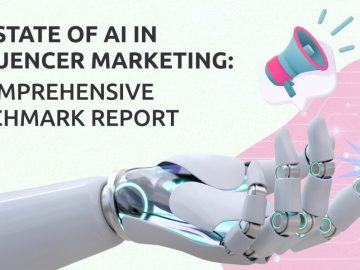With 50% of consumers able to detect AI-generated content, Foleon’s Penny Warnock (brand content specialist) explores how to use AI for efficiency whilst maintaining authenticity through personalized, human-centric content.
Since OpenAI’s ChatGPT came onto the scene, the rules of the marketing game have drastically changed. With global market shifts and Gen Z entering the workforce, the average consumer is more in tune with brands’ values and ethics. A recent study by Bynder found that 50% of consumers can detect content generated by artificial intelligence (AI), and 52% were less engaged when reading AI-generated copy. People quickly see through superficial and overly polished AI-generated material. For us marketers, there are two real challenges here.
First, there’s the technical aspect of leveraging AI’s benefits without letting it strip your content of its soul. Second, the creative challenge is maintaining a distinct human voice and engaging with your audiences with personalized experiences.
Let’s get into it.
The impact of AI on content creation
When OpenAI released its first demo almost overnight, every marketer had a shiny new tool. The possibilities felt endless. Within five days of its release, ChatGPT gained one million users, making it the fastest-growing consumer application. Pretty quickly, everyone and their mother were talking about AI.
The wonder and awe did not last long; having quickly realized that ChatGPT is inherently flawed and that most content created with the tool was bland and forgettable, the problems were aplenty. The content was often generic, sometimes incoherent, and regularly riddled with inaccuracies. Many of us spent more time fixing AI-generated content than creating it from scratch.
Fast-forward to 2024. Google has had to alter its algorithm to crack down on spammy AI content polluting our feeds, and the AI investment bubble is close to bursting. Now, consumers are well aware of the amount of AI-generated content online and are allergic to it. Enter AI’s most potent rival: Authenticity.
AI and the shift toward authenticity
Despite all the techy advancements, running a successful business today is far more complicated than twenty or thirty years ago. Back then, business owners only had to provide good products and services to make customers happy. These days, it’s a lot more complex.
As mentioned, along with the rise in AI adoption, there is an even greater demand for transparency and authenticity. The 2023 Edelman Trust Barometer shows this shift: 79% of Gen Zers emphasize the importance of trusting brands more now than in the past, compared to 61% of Baby Boomers. This shows a distinct generational pivot towards authenticity regarding branding.
As a result, brands are now finding that authenticity or a distinct point of view isn’t just nice to have — it’s essential equipment to battle the AI-generated content boom.
Authenticity vs. AI
So, what do we mean by authenticity?
In this case, I am referring to your brand’s point of view, your beliefs, and your values.
People are far more likely to buy from a brand when they relate to its values or when you stand for something. It’s no longer enough to simply say we’re a sustainable brand with no action to back it up. People expect brands to be fully-fledged beings with belief systems and actions to back them up.
As AI becomes more capable of producing vast quantities of content quickly and cheaply, there’s a growing sense of discomfort when you come across content that feels too polished or detached from the human touch. Consumers can quickly tell between content that speaks to them personally and just noise generated to fill space.
This means a new way of marketing has emerged. Marketers must figure out how to find the sweet spot between leveraging AI to scale and streamline while ensuring you provide an engaging, personalized experience for your audience.
Let’s talk about it.
Balancing AI and personalized experiences
Like I said before, AI will not win trophies, but you need it to play the game. Those who don’t leverage AI’s benefits will be left behind, but those who rely too heavily on it will be filtered out pretty quickly. The general consensus is that you have to use AI in the right way, and most people simply are not doing that. So, how can you balance efficiency with authenticity?
As we know, AI can make your life so much easier. It can be a powerful tool for manual tasks, analyzing data, or identifying patterns. It’s very helpful for creating personalized and relevant content. These days, personalized experiences go a long way. Epsilon research shows that 80% of customers are more likely to do business with a brand when they provide personalized marketing experiences.
With a personal touch, you boost trust with your audience and make them feel seen and heard. AI can help you create more authentic experiences by allowing you to tailor messages to individual preferences, making your content more engaging.
However, a strict and detailed editorial process is essential for ensuring AI-generated content is still human. Never let AI do everything. You have to rigorously check and refine AI output, correct inaccuracies, and ensure the content is infused with your brand’s voice. I recommend creating a checklist focusing on elements AI might overlook. For example, I always verify any facts and figures.
Finally, gathering and responding to audience feedback is one of the best ways to build trust. Be open about AI’s role in your work, whether it’s a content creation assistant or more. Actively seek your audience’s input to create a more authentic connection.
Let’s explore some best practices to avoid creating generic content nobody wants to read.
4 best practices for avoiding generic content
1. Find a POV
One of the best ways to be authentic is to find a distinct point of view; this should be how your brand sees the world and reflects your core brand values. Today’s most loved brands have a solid, recognizable, consistent personality. You don’t need to be unhinged, but you do need to have some character. This way, you can stand out in that sea of AI-generated sameness.
2. Be human
Real stories, human faces, and behind-the-scenes content are all effective tactics for showing the human side of your brand. When your customers connect with your brand, they don’t need to be enticed to buy from you; there’s no need for sneaky marketing tactics; they purchase from you because they want to.
3. Go for engagement
AI lets you generate vast amounts of (generic) content easily, so in the crowded content market, focusing on creating engaging content or interactive content is a solid game plan. Focusing on high-quality, valuable content your audience can interact with helps you build a community within your audience, helping maintain that human connection and avoid the pitfalls of forgettable content.
4. Use AI for efficiency
Use AI for the tasks it excels at—think data analysis, content optimization, and repetitive tasks. Take some time to create personalized prompts. Feed as much information as possible, such as your tailored audience profiles, preferred tone of voice, etc., to ensure the AI-generated content aligns. This way, you can focus on editing, creativity, and strategy.
Conclusion
Despite the hype, AI won’t rescue marketers from bad brands, terrible writing, or weak messaging.
AI is the equipment you need to play the game—it won’t win the championship for you, but it’s crucial for staying in the game. The trick is to balance efficiency with authenticity and personalized experiences. Use AI to enhance, not replace, human creativity and connection.





